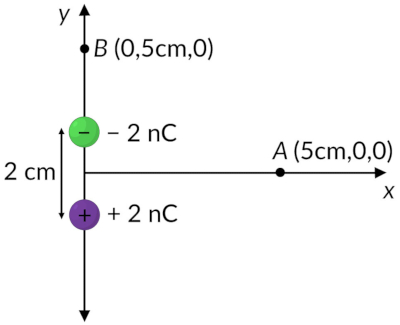24.7:
Calculations of Electric Potential II
An electric dipole is a system of two equal and opposite charges. Consider a dipole along the vertical axis with a positive charge at point M and a negative charge at point N, separated by distance d. What is the electric potential at point A at a distance r from the origin?
The potential at point A is the algebraic sum of the potential due to both the charges. Here, the distance rAM can be rewritten using the Pythagoras theorem.
If r is far greater than d, polar coordinates can be used. The terms from the expression can be rearranged by expanding the terms in the parentheses, and further neglecting the smaller terms gives the simplified expression for rAM.
A similar analysis gives the expression for rAN. The binomial approximation simplifies these expressions further, and substituting them gives the electric potential due to an electric dipole.
The electric potential decreases as the square of the r and depends on the dipole moment's direction, where the dipole moment is the charge multiplied by the separation between the charges.
24.7:
Calculations of Electric Potential II
An electric dipole is a system of two equal but opposite charges, separated by a fixed distance. This system is used to model many real-world systems, including atomic and molecular interactions. One of these systems is the water molecule, but only under certain circumstances. These circumstances are met inside a microwave oven, where electric fields with alternating directions make the water molecules change orientation. This vibration is equivalent to heat at the molecular level.
Consider a dipole with charges 2 nC and -2 nC, with a separation of 2 cm between them, situated at the origin. What will be the electric potential due to this dipole at positions A (5 cm, 0, 0), and B (0, 5 cm, 0)?

The electric potential due to the dipole is given by the following equation
For position A, the electric potential is calculated on the x-axis, for which the angle between the position vector and the dipole moment is 90 degrees. Therefore the electric potential due to the given electric dipole at position A is
For position B, the electric potential is calculated on the y-axis, for which the angle between the position vector and the dipole moment is 0 degrees. Therefore the electric potential due to the given electric dipole at position B is
Suggested Reading
- OpenStax. (2019). University Physics Vol. 2. [Web version]. Retrieved from https://openstax.org/details/books/university-physics-volume-2; section 7.3; page 308-311.
